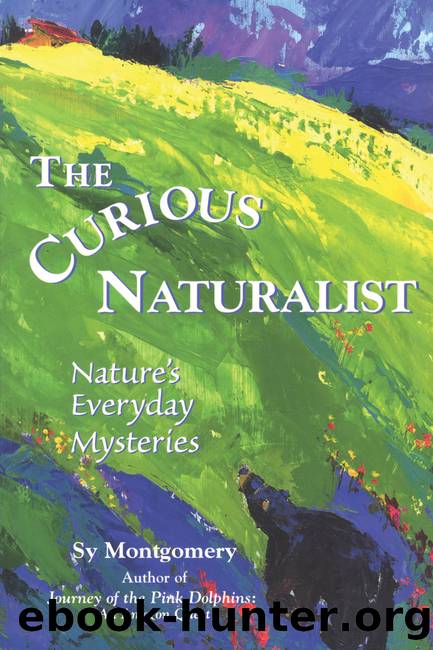The Curious Naturalist: Nature's Everyday Mysteries by Sy Montgomery

Author:Sy Montgomery [Montgomery, Sy]
Language: eng
Format: epub
Tags: nature, Essays
ISBN: 9781608934348
Google: OOdXBAAAQBAJ
Publisher: Down East Books
Published: 1991-01-01T21:42:26+00:00
Pods
Blueprints for Immortality
Blinded by the blaze of autumnâs foliage, we often miss what is, from the plantâs point of view, its most spectacular efforts. After all, a plantâs crowning achievement is neither its youthful flowers nor autumn leaves, but its blueprints for immortality: fruit, pods, and seed heads. And long after autumnâs brilliant leaves have been raked away, these structures will continue to offer a harvest of strange and beautiful forms.
âOur appetites have commonly confined our views of ripeness . . . to the fruits we eat,â Thoreau wrote in his journal in October of 1858, âand we are wont to forget that an immense harvest which we do not eat, hardly use at all, is annually ripened by nature . . . fruits which address our taste for beauty alone.â
Fruits, pods, and seeds offer stunning colors, fantastic shapes: some are shaped like Japanese lanterns; others look like space capsules from Mars; one tall, puffy pod looks like the fanciful common name for this lily: Turkâs cap.
Youâll find much of this wild harvest worthy of your favorite vase. âTo me, the empty seed containerâthe podâis another of natureâs works of art, as beautiful as the flower and as unique in its own form,â Wisconsin watercolorist Jane Embertson believes. So taken was she with this often-overlooked beauty that she wrote a guide to using berries, seeds, and pods in floral arrangements, entitled Pods: Wildflowers and Weeds in Their Final Beauty.
Astersâ fuzzy tufts hold little round clusters of silky seed heads, which can be used in arrangements as you would babyâs breath. Blue bead lilyâs beautiful deep blue, round berries branch out in a starburst pattern from the top of the leafless stalk and make stunning accents. Common milkweedâs warty pods erupt with feathery parachutes of seeds, leaving soft, pale orange tongues clinging to silky yellow exteriors.
Many of these shapes and colors would grace gardens as well as wild placesâbut, notes Heather McCargo, New England Wild Flower Societyâs plant propagator, âmost gardeners hack everything back after it blooms.â
So, also, we miss many grassesâ graceful seed heads: wild oats, for instance, sport clusters of flattened chevrons on chartreuse stems; Grayâs sedge grows an astonishing mace-shaped seed head an inch across. âBut we donât see them,â says McCargo, âbecause we mow everything in sight.â (Fortunately, at the Societyâs Garden in the Woods in Framingham, Massachusetts, they donât; so there, as well as in your local woods, fields, and swamps, you can see many of these pods, fruits, and nuts still on the plant.)
All of these structures are vehicles for seeds. A look at their shapes foretells their travels: milkweedsâ parachutes and maplesâ whirligig pods are designed to ride the wind. Well-named sticktights and burdock burrs hitchhike on fur and clothing. Lantern or bladder-shaped pods of wetland species like water chestnut are designed to float like buoys on trips downstream. A few are entirely self-propelled: jewelweedâs seeds literally shoot off the plant if you brush against it. (Peel away the thin green pod for a tasty walnutÂflavored field snack.
Download
This site does not store any files on its server. We only index and link to content provided by other sites. Please contact the content providers to delete copyright contents if any and email us, we'll remove relevant links or contents immediately.
The Lonely City by Olivia Laing(4768)
Animal Frequency by Melissa Alvarez(4424)
All Creatures Great and Small by James Herriot(4267)
Walking by Henry David Thoreau(3921)
Exit West by Mohsin Hamid(3791)
Origin Story: A Big History of Everything by David Christian(3665)
COSMOS by Carl Sagan(3584)
How to Read Water: Clues and Patterns from Puddles to the Sea (Natural Navigation) by Tristan Gooley(3430)
Hedgerow by John Wright(3313)
How to Read Nature by Tristan Gooley(3289)
The Inner Life of Animals by Peter Wohlleben(3282)
How to Do Nothing by Jenny Odell(3263)
Project Animal Farm: An Accidental Journey into the Secret World of Farming and the Truth About Our Food by Sonia Faruqi(3189)
Origin Story by David Christian(3169)
Water by Ian Miller(3154)
A Forest Journey by John Perlin(3042)
The Plant Messiah by Carlos Magdalena(2900)
A Wilder Time by William E. Glassley(2833)
Forests: A Very Short Introduction by Jaboury Ghazoul(2814)
